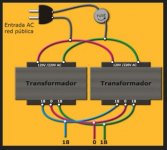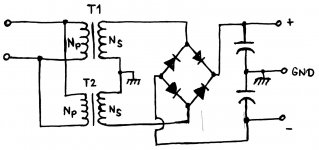FauxFrench,
zman01 wanted a dual rail (+ & -) supply. In your answer number 2), You said use a single bridge to get that.
Could you please post a schematic of how to do that?
The only way I know of to get dual rail supply with only 1 bridge, is to use a resistive spitter, or some other combination of zener and resistors, active devices, etc.
That does not seem to be very efficient.
zman01 wanted a dual rail (+ & -) supply. In your answer number 2), You said use a single bridge to get that.
Could you please post a schematic of how to do that?
The only way I know of to get dual rail supply with only 1 bridge, is to use a resistive spitter, or some other combination of zener and resistors, active devices, etc.
That does not seem to be very efficient.
Could you please post a schematic of how to do that?
The series connection of the two secondaries forms a center tap, which is grounded in this circuit.
Dual Power Supply Circuit-12 Volt Regulated Power Supply|Diagram
Last edited:
FauxFrench,
zman01 wanted a dual rail (+ & -) supply. In your answer number 2), You said use a single bridge to get that.
Could you please post a schematic of how to do that?
The only way I know of to get dual rail supply with only 1 bridge, is to use a resistive spitter, or some other combination of zener and resistors, active devices, etc.
That does not seem to be very efficient.
Attachments
if you blast it constantly, both trannies are required. if you occasionally take it to full output ( or less ) a single transformer will do.you have to remember that music is dynamic and those transformers are capable of a constant 200 watts of output. class D is also 95% effiecient in getting supply power to the speakers.
if you need 40 Vac, you need to connect the secondaries in series leaving the center tap on both transformers unconnected. the new center tap will be the point where both trannies are connected. if you are out of phase 0 volts wil be seen , in phase 40 Vac will be across the leads
if you need 40 Vac, you need to connect the secondaries in series leaving the center tap on both transformers unconnected. the new center tap will be the point where both trannies are connected. if you are out of phase 0 volts wil be seen , in phase 40 Vac will be across the leads
Last edited:
Stocktrader200 is right. Due to the crest factor of most music you can get far with a single 200VA transformer ("trannie", should we find ourselves in beautiful Canada). Just make sure you have sufficiently sized decoupling capacitors.
My circuit diagram addressed the question: can a single symmetrical-winding transformer be replaced by two transformers with half the power each? My impression is yes, using two transformers each having one similar secondary winding and connect them in series (with appropriate phasing evidently).
My circuit diagram addressed the question: can a single symmetrical-winding transformer be replaced by two transformers with half the power each? My impression is yes, using two transformers each having one similar secondary winding and connect them in series (with appropriate phasing evidently).
Last edited:
FauxFrench,
You have a good point, all that is needed is one bridge. I did not see that before you posted the schematic.
The only thing to remember is that both secondaries will be loaded on positive and negative alternations. That is a full load on each secondary. It will have to be calculated as to whether each secondary has enough power to power the + and - loads.
You have a good point, all that is needed is one bridge. I did not see that before you posted the schematic.
The only thing to remember is that both secondaries will be loaded on positive and negative alternations. That is a full load on each secondary. It will have to be calculated as to whether each secondary has enough power to power the + and - loads.
Question about power supply.
I have a dual supply.
Can I use this to run two single mono amps? (They require a single supply, not + -)
Is there a danger with polarity?
I have a dual supply.
Can I use this to run two single mono amps? (They require a single supply, not + -)
Is there a danger with polarity?
If you are thinking what I think you are, impossible to be certain without you drawing a diagram, then the centre tap and the negative supply will be shorted via the common signal returns
I have a rectified supply fed by a center tap transformer. On the PS I get + 35v on one side (VDD/POS as relating to ground) and - 35v on the other (VEE/NEG to ground). 70v DC between + and -. This powers an amp that requires a + - supply.
I wonder if I could use the supply to power two separate amps that require just 35v.
Seems to me it would work but with opposite phase?
Thanks.
P.S.
I mean power one amp from the + and ground taps and another from the - and ground taps.
Thanks
I wonder if I could use the supply to power two separate amps that require just 35v.
Seems to me it would work but with opposite phase?
Thanks.
P.S.
I mean power one amp from the + and ground taps and another from the - and ground taps.
Thanks
Last edited:
You can't reverse the polarity for one of the amps. Does the transformer have 3 or 4 wires coming from the secondary?
4 wires.
In current set up the red is connected +, the Yellow - and the Black and Orange tied together to ground.
In current set up the red is connected +, the Yellow - and the Black and Orange tied together to ground.
Then you can disconnect black and orange and rectify and smooth each secondary separately and have two independant supplies
Thanks so much for that.
I figured it might work the other way but the polarity scared me.
That's why I ask first. I am a pro musician who has fun building stuff.
I figured it might work the other way but the polarity scared me.
That's why I ask first. I am a pro musician who has fun building stuff.
Killed a guitarist colleague long time ago. Not really a friend but we had played together a couple times.
Left hand on electric guitar, right hand on microphone.
Vocal PA and monitors on different phase than the instrument amps. Outdoor party. I wasn't on that gig.
Left hand on electric guitar, right hand on microphone.
Vocal PA and monitors on different phase than the instrument amps. Outdoor party. I wasn't on that gig.
Say, you have a dual +15V/-15V supply and two amplifiers that require 15V (single) each.
You can operate both from the +15V to ground and leave the -15V unused. A bit a waste of the power supply capacity.
You can in theory operate one amplifier between +15V and ground and the other between ground and -15V, but then you have different signal grounds and that is going to be more difficult to overcome than what you gain. Not recommended.
In case you have a dual (symmetrical) power supply and single supply amplifiers capable of using the maximum output voltage (+ to -), you can do so. Just watch out for sufficient current capacity from the power supply now operating two amplifiers from full voltage. And, watch out for what you use as signal ground.
If you have a dual (symmetrical) power supply and single supply amplifiers only capable of using a single polarity voltage (+ to ground), redesign your symmetrical power supply (with a net transformer) such that each of the symmetrical windings (with a center tap) are single rectified to the same single polarity rail. Like this, you can get more than half of the theoretical max. power out of the transformer because each of the windings are loaded alternatively and the heating from winding losses is less.
You can operate both from the +15V to ground and leave the -15V unused. A bit a waste of the power supply capacity.
You can in theory operate one amplifier between +15V and ground and the other between ground and -15V, but then you have different signal grounds and that is going to be more difficult to overcome than what you gain. Not recommended.
In case you have a dual (symmetrical) power supply and single supply amplifiers capable of using the maximum output voltage (+ to -), you can do so. Just watch out for sufficient current capacity from the power supply now operating two amplifiers from full voltage. And, watch out for what you use as signal ground.
If you have a dual (symmetrical) power supply and single supply amplifiers only capable of using a single polarity voltage (+ to ground), redesign your symmetrical power supply (with a net transformer) such that each of the symmetrical windings (with a center tap) are single rectified to the same single polarity rail. Like this, you can get more than half of the theoretical max. power out of the transformer because each of the windings are loaded alternatively and the heating from winding losses is less.
Last edited:
PLEASE stop using the word "phase" here, where we are talking DC .I have a rectified supply fed by a center tap transformer. On the PS I get + 35v on one side (VDD/POS as relating to ground) and - 35v on the other (VEE/NEG to ground). 70v DC between + and -. This powers an amp that requires a + - supply.
I wonder if I could use the supply to power two separate amps that require just 35v.
Seems to me it would work but with opposite phase?
Thanks.
P.S.
I mean power one amp from the + and ground taps and another from the - and ground taps.
Thanks
You´ve been told so many times, but you insist, making me think you do not know its meaning.
No discussion on power supplies can go on if you ignore basic concepts.
- Status
- Not open for further replies.
- Home
- Amplifiers
- Power Supplies
- Dual Transformer Power supply Question

